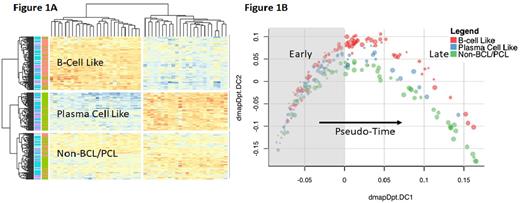Abstract
Background: Waldenström's Macroglobulinemia (WM) is characterized by recurring mutations in MYD88 (95-97%) and CXCR4 (40%). While these genomic insights have heralded new insights into disease pathogenesis and treatment, a multi-omic approach in a large population of WM patients may further clarify underlying disease biology.
Methods: Stranded 150bp paired end RNA sequencing was performed on CD19+ bone marrow (BM) biopsies from 253 treatment-naive WM patients along with paired CD19+CD27- and CD19+CD27+ peripheral blood (PB) cells from 13 healthy donors. For 216 patients, whole exome sequencing of CD19+ BM WM cells with CD19- PB controls was also performed. All p-values were subjected to correction using the false discovery rate.
Results: Baseline characteristics were typical of treatment-naive patients. Their median age was 66 years; BM disease involvement 50% ; and serum IgM 3,108 mg/dL. The median follow-up was 7.5 years. MYD88 mutations were identified in 250 (98.8%) patients. Exploratory analysis of MYD88 mutated patients revealed three distinct groups of patients that were observed in a hierarchical clustering analysis shown in Fig 1A. Gene set enrichment analysis revealed distinct B-cell Like (BCL) and Plasma Cell Like (PCL) patient groupings and a third non-BCL/PCL patient group that clustered independently. Non-BCL/PCL patients were more likely to be asymptomatic (36/84; 43%) versus those in the BCL (62/96; 64.6%) and PCL (48/68; 70.6%) groups (p<0.005). Among BCL and PCL grouped patients, important differences in disease presentation were noted including BM involvement (50% vs. 70%; p<0.001), adenopathy (18.6% vs. 48.4%; p<0.002), CD10 (1.1% vs. 13.4%; p=0.012), CD23 (39.4% vs. 22.4%; p=0.09) and CD5 (19.1% vs. 6%; p=0.09) expression, respectively. CXCR4 mutations were identified in 76/97 (78.4%) of BCL versus 6/69 (8.7%) of PCL patients (p<0.001). Amplifications in chr18q amplifications were also more prevalent in BCL (14/83; 16.9%) versus PCL (1/64; 1.6%) grouped patients (p=0.035). chr6q deletions were observed in 24/83 (29%) of BCL versus 30/64 (47%) PCL patients (p=0.11). BCL patients also exhibited fewer chr6p amplifications, i.e. 3/83 (3.6%) versus 12/64 (18.8%) of PCL patients (p=0.036). Differences in deletions in chr17p (0/83; 0%) vs (6/64; 9.4% (p=0.036); as well as NOTCH1 (0/82; 0%) vs. (6/64; 9.4%) (p=0.084) and EP300 3/82; 3.7%) vs. (11/64; 17.2%) (p=0.084) mutations were also identified in BCL vs PCL patients, respectively. NOTCH pathway mutations were also found in fewer BCL (17/82; 20.7%) versus PCL (30/64; 46.9%) patients (p=0.01). Diffusion mapping and pseudo-time analysis were performed on the top 1,000 high variance genes which bifurcated patients into two distinct populations over time as shown in Fig. 1B, with the point size scaled for BM involvement. By diffusion pseudo-time (DPT), patients were stratified into early- and late-stage WM, the former showing lower median BM involvement (30% vs. 70%; p<0.001) and serum IgM (2,666 vs. 3713; p=0.133); higher hemoglobin (12.1g/dL vs.
10.65g/dL; p<0.001), serum IgA (56.5mg/dL vs. 41mg/dL; p=0.018) and IgG (629mg/dL vs. 498mg/dL; p=0.015), and less splenomegaly (3.7% vs. 17.2%; p=0.006). A longer time to first treatment (5.3 vs 0.9 months; (p<0.001) was also observed in those with early- versus late- stage WM, respectively. DPT showed that the non-BCL/PCL patients were more likely to be early stage (68/84; 81%) versus BCL (51/97; 53%) and PCL (30/69; 43%) grouped patients (p<0.001). In addition, hierarchical clustering delineated the non-BCL/PCL group into two subgroups with CXCR4 mutations rates of 30/57 (52.6%) and 2/27 (7.4%), and gene expression similarities that aligned with either the BCL or PCL subtypes, respectively. Taken together, these findings suggest that the non-BCL/PCL group represents an earlier evolving stage of WM that may progress into BCL and PCL like WM disease.
Conclusions: In this largest multi-omic investigation undertaken into WM, we identified three distinct WM subtypes with distinct clinical and genomic features. Central these findings were the identification of BCL, PCL, and an earlier non-BCL/PCL evolving stage recognized through DPT modeling. The discovery of the DPT model for WM disease progression provides insight into the biology and targeting of WM progression. Our findings provide a critical framework for multi-omic based study and targeted treatment approach to WM.
Disclosures
Sarosiek:BeiGene: Consultancy; ADC Therapeutics: Research Funding. Branagan:Genzyme: Consultancy; Adaptive Biotechnologies: Consultancy; Janssen/Pharmacyclics: Consultancy; BeiGene: Consultancy; Karyopharm Therapeutics: Consultancy; CSL Behring: Consultancy. Yang:Blueprint Medicines: Current Employment. Anderson:Pfizer: Membership on an entity's Board of Directors or advisory committees; Mana Therapeutics: Membership on an entity's Board of Directors or advisory committees; Amgen: Membership on an entity's Board of Directors or advisory committees; AstraZeneca: Membership on an entity's Board of Directors or advisory committees; Janssen: Membership on an entity's Board of Directors or advisory committees; Precision Biosciences: Membership on an entity's Board of Directors or advisory committees; Window: Membership on an entity's Board of Directors or advisory committees; Starton: Membership on an entity's Board of Directors or advisory committees; OncoPep: Other: Scientific founder ; C4 Therapeutics: Other: Scientific founder ; Raqia: Other: Scientific founder ; NextRNA: Other: Scientific founder ; Dynamic Cell Therapy: Current holder of stock options in a privately-held company, Membership on an entity's Board of Directors or advisory committees. Munshi:GSK: Consultancy; Karyopharm: Consultancy; Abbvie: Consultancy; Amgen: Consultancy; Janssen: Consultancy; Bristol-Myers Squibb: Consultancy; Legend: Consultancy; Celgene: Consultancy; Pfizer: Consultancy; Adaptive Biotechnology: Consultancy; Novartis: Consultancy; Oncopep: Consultancy, Current equity holder in publicly-traded company, Other: scientific founder, Patents & Royalties; Takeda Oncology: Consultancy. Castillo:TG Therapeutics: Research Funding; Cellectar: Consultancy; AstraZeneca: Research Funding; Pharmacyclics: Consultancy, Research Funding; Janssen: Consultancy; Roche: Consultancy; Beigene: Consultancy, Research Funding; Abbvie: Consultancy, Research Funding. Treon:Janssen/Pharmacyclics: Consultancy, Research Funding; Abbvie: Consultancy; BeiGene: Consultancy; X4: Consultancy, Research Funding; BMS: Research Funding.
Author notes
Asterisk with author names denotes non-ASH members.


This feature is available to Subscribers Only
Sign In or Create an Account Close Modal